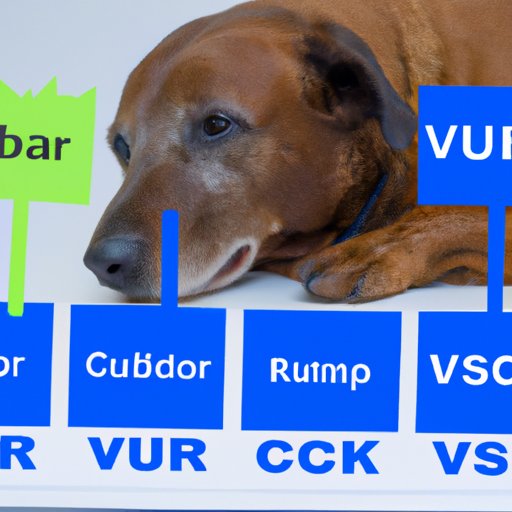Introduction
Skin cancer is a common type of cancer in humans, but did you know that it can affect dogs as well? This article will explore the types of skin cancer in dogs, the symptoms to look for, causes and risk factors, diagnosis and treatment options, and prevention strategies.
Exploring the Types of Skin Cancer in Dogs
There are three main types of skin cancer in dogs: basal cell carcinoma, squamous cell carcinoma, and malignant melanoma. Each type has its own set of characteristics and potential treatments.
Basal Cell Carcinoma
Basal cell carcinoma (BCC) is the most common type of skin cancer in dogs. It typically occurs in older dogs and is characterized by raised, firm, and hairless lesions on the head, neck, and forelimbs. BCCs can be benign or malignant, but they do have the potential to spread if not caught early.
Squamous Cell Carcinoma
Squamous cell carcinoma (SCC) is the second most common type of skin cancer in dogs. It is usually found on the head, muzzle, lips, and ears. SCCs are usually slow-growing but can become aggressive if left untreated. They also have the potential to spread to other parts of the body.
Malignant Melanoma
Malignant melanoma is the least common type of skin cancer in dogs but is the most aggressive. It is usually found on the mouth, nail beds, feet, and anal area. Melanomas can spread quickly and are often fatal if not treated promptly.
The Symptoms of Skin Cancer in Dogs
The symptoms of skin cancer in dogs vary depending on the type of cancer. The most common signs to look for include:
- Raised bumps or lumps on the skin
- Redness, itching, or irritation of the skin
- Hair loss or discoloration of the skin
- Ulcerations or sores that won’t heal

Causes and Risk Factors for Canine Skin Cancer
The exact cause of skin cancer in dogs is unknown, but some factors may increase the risk. These include:
Exposure to UV Light
Exposure to ultraviolet (UV) light from the sun is one of the biggest risk factors for skin cancer in dogs. Dogs with lighter coats are more susceptible to the damaging effects of UV light and should be protected with sunscreen when outdoors.
Age
Older dogs are more likely to develop skin cancer than younger dogs. This is because their immune systems are weaker and their skin is thinner, making them more vulnerable to the effects of sunlight.
Breed
Certain breeds of dogs are more prone to skin cancer than others. Breeds such as Boxers, Bulldogs, Poodles, and Golden Retrievers are more likely to develop the disease.
Other Risk Factors
Other factors that may increase the risk of skin cancer in dogs include a weakened immune system, exposure to chemicals, and genetic predisposition.

Diagnosis and Treatment of Skin Cancer in Dogs
If your dog shows any of the symptoms of skin cancer, it is important to take him to the vet for a diagnosis. The vet will perform a physical exam and may order additional tests such as a biopsy or blood work.
Diagnostic Tests
The vet may recommend one or more diagnostic tests to determine if your dog has skin cancer. These tests may include a skin scraping, biopsy, or X-ray. The results of these tests will help the vet make an accurate diagnosis.
Treatment Options
Treatment for skin cancer in dogs depends on the type and stage of the cancer. Options may include surgery, chemotherapy, radiation therapy, or immunotherapy. Your vet can discuss the best course of treatment for your dog’s individual situation.

Prevention Strategies for Skin Cancer in Dogs
Although there is no sure way to prevent skin cancer in dogs, there are some steps you can take to reduce the risk. These include:
Protecting Your Dog From UV Light
Protect your dog from excessive UV light exposure by keeping him indoors during peak hours of the day and applying sunscreen before taking him outside. Be sure to choose a sunscreen specifically designed for dogs.
Regular Vet Visits
Regular checkups at the vet can help catch skin cancer in its early stages. Be sure to bring your dog to the vet at least once a year for a checkup.
Diet and Exercise
A healthy diet and regular exercise can help keep your dog’s immune system strong and reduce the risk of skin cancer. Feed your dog a balanced diet and provide plenty of opportunities for exercise and playtime.
Conclusion
Skin cancer is a serious condition that can affect dogs as well as humans. Knowing the types, symptoms, causes, and risk factors can help you recognize the signs early and get prompt treatment for your pet. Protecting your dog from UV light, scheduling regular vet visits, and maintaining a healthy diet and exercise routine can all help reduce the risk of skin cancer.
If you think your dog may have skin cancer, don’t wait to get help. Contact your veterinarian right away for an examination and diagnosis.


